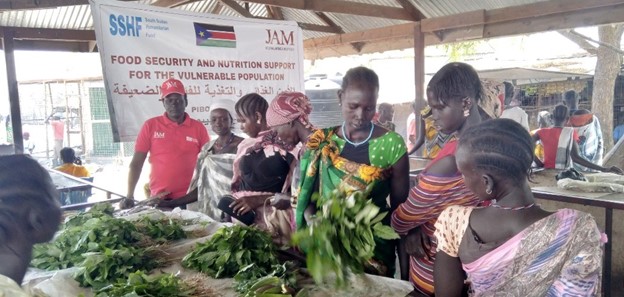Pooled funds provide livelihood and nutrition help to vulnerable people in South Sudan
South Sudan | 2021 | CBPF
South Sudan. Mary used to brew alcohol to earn money, but it wasn’t a reliable business. Married, but with her husband working elsewhere, she could not afford the education fees for her five children as well as basic living expenses.
In 2021, poor harvests, flooding, and conflict throughout South Sudan led many families like Mary’s to face mounting food insecurity.
OCHA’s Country-Based Pooled Funds (CBPFs) and the Central Emergency Response Fund (CERF) are some of the most effective ways to ensure that life-saving assistance reaches people caught up in crises.
In South Sudan and many other emergencies, the Funds work together to ensure the neediest people caught up in crisis receive the support they need, in South Sudan, funding food security, livelihoods, and nutrition in different regions of the country.
In Tonj South, CERF supported WFP in scaling up a Food Assistance project to improve nutrition and reduce hunger through vegetable gardens. The project taught the most vulnerable community members basic agricultural skills, allowing them to sell their products in the market. For Mary, the vegetable plot earns her enough money to buy food at the same market, medication and to pay for three of her children to attend school.
In Tonj North, CERF supported an FAO project with similar aims, distributing seeds, tools and fishing kits for 5,000 households. Aduol, also a mother of five, received seeds and training on planting and cultivation. “I was able to plant twice,” she said, “and I obtained a good harvest in my first field and am hoping for the same with my second.”
Meanwhile, in greater Pibor, the South Sudan Humanitarian Fund supported NGO Joint Aid Management (JAM) to provide integrated food security and nutrition support for 60,000 people. Mary, living in Pibor, was able to get nutrition treatment for her baby daughter. She was also able to expand her vegetable garden to two acres, saving the money she earned selling vegetables to buy a water pump so that she could grow even more.
The CBPF and the CERF funding was sequenced to most strategically support the response at the right time and in the right places.
In January, CERF allocated $7 million to mitigate the risk of food insecurity and promote resilience; while the SSHF provided $4 million for agricultural and livelihood support. In April, CERF allocated $10 million for a multi-sectoral response timed to coincide with SSHF-funded seed distribution. And in July, the SSHF disbursed a further $28.5 million to sustain the response. This allocation also pre-positioned emergency rations and livelihood kits ahead of the dry season, resulting in broad and longer-term support of nutrition and Food Security and Livelihood activities across South Sudan.
2021
More information on the CERF allocations:
https://cerf.un.org/what-we-do/
